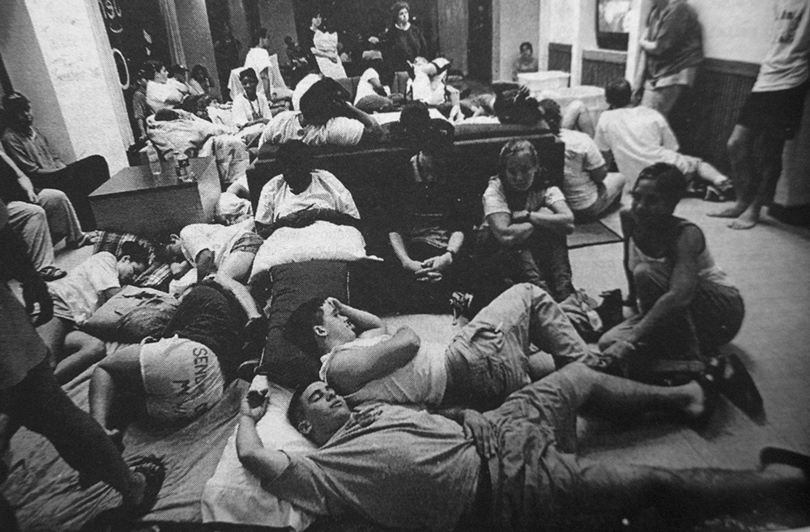Students, faculty reflect on cancellation of classes for 1998 storm
When strong winds began shaking Lawrinson Hall, Tony Kudner thought a tornado was coming.
Kudner, then a freshman production and theatrical design major, ran into the room next door and saw his friend, who had “had a couple beers,” holding onto the window and screaming as the wind rushed in.
“That’s when everyone realized the difference between it being a thunderstorm and it being something more serious,” he said.
The Labor Day 1998 storm caused the cancellation of classes for a day, injured two people and caused widespread damage on the Syracuse University campus. Trees were uprooted, roads were closed and windows were shattered in Day and Lawrinson halls, causing water damage.
South Campus was hit the hardest by the storm, which caused power outages in all the apartments and tore the roof off 12 Slocum Heights apartments.
The cancellation of classes for part of Monday and all of Tuesday in response to Hurricane-turned Superstorm Sandy is the first time since Sept. 7, 1998, that classes were canceled due to a storm.
Kenneth “Buzz” Shaw was chancellor at the time of the 1998 storm. Shaw said he slept through the storm, which occurred on a Sunday night, and awoke to reports of the storm and the damage it had caused.
When Shaw arrived at the university, he said the atmosphere was “eerie,” and that the amount of fallen trees and other destruction made campus look like it had “been through a war or something.”
“We made the decision to cancel classes because people were too upset to do anything,” he said.
Because the university had endured other emergency situations, like the Pan Am Flight 103 bombing, procedures were already in place to deal with the storm, Shaw said.
The university first focused on the safety of the campus community and relocating people whose housing was no longer livable. The focus then turned to cleaning up the damage. SU was able to get FEMA grants to pay for much of the clean up, he said.
But getting the university back to normal was a long process, he said.
“My wife and I walked around campus a lot that (first) day,” Shaw said. “Then we started picking up the pieces.”
While dealing with the aftermath of the storm was difficult, Shaw said, people were great about handling it.
“A lot of people stepped up and put in extra time,” he said.
Mark Owczarski was one of those people. Owczarski, a university spokesman, said the hardest part of the job was notifying students of the canceled classes.
“We couldn’t tweet or Facebook or text message back then,” he said. “I look back and think, ‘How did we survive without it?’”
Instead, the university relied on “old-school communication” methods such as email, said Owczarski, now director of news and information at Virginia Polytechnic Institute. He recalls driving Shaw and his wife to the Syracuse television stations and the Syracuse Post-Standard so they could be interviewed about what was going on.
Even though the trip was only to downtown Syracuse, it took “forever” to get there because of all the fallen trees and closed roads, Owczarski said.
But the “big story” of the 1998 storm was the destruction of several married student apartments on South Campus, displacing many families and married couples, Owczarski said.
Many of these people were temporarily relocated to various hotels near SU, he said, and it took a while to rebuild the apartment buildings, one of which was damaged beyond repair.
But the storm’s destruction brought the campus community together due to the “burden of shared experience,” said Jacob Bendix, associate professor of geography at SU.
The cancellation of classes was tough, though, Bendix said, because classes were only canceled for a day, but many faculty members were unable to get to campus for several days due to road closures and fallen trees.
“But the university didn’t want students just sitting in their dorms with nothing to do, so they started classes again,” he said.
Bendix lived in DeWitt at the time and said he had to take back roads to work, but otherwise didn’t experience much trouble.
The strong winds also destroyed many trees on campus, permanently changing the campus landscape, he said.
These strong winds caused many students to think a tornado had hit campus.
As Kudner and his roommate ran down 16 flights of stairs to the Lawrinson Hall basement, the two got off on various floors to warn students of the coming storm.
“We just got off at different floors and were shouting ‘Tornado!’” he recalled. “People were coming out of their rooms, half asleep in their pajamas. We just kept telling people to get to the basement.”
Despite the danger the storm brought, Kudner remembers lighter moments too.
“I remember my roommate performing CPR on a girl’s teddy bear that had fallen out the window,” he said with a laugh.
Justin Brody lived on the second floor of Day Hall at the time and said he also remembers being told to go into the basement of the residence hall.
He described the scene in the basement as “crazy” and recalls people being injured by broken glass and girls screaming.
The next day, campus was “pretty beat up” and trees were down everywhere, Brody said. For the then-freshman finance major, the storm was quite an introduction to SU and college life.
“We were two or three weeks into school and there was this huge tornado storm,” he said. “It was crazy.”
Published on October 30, 2012 at 12:29 am
Contact Jessica: [email protected] | @JessicaIannetta






